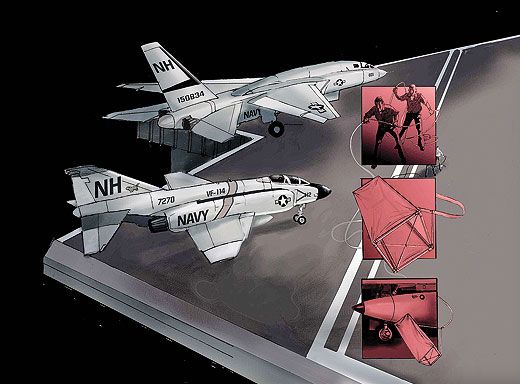Flights & Fancy: How I Bagged an F-4J
Who would think a kite could down a fighter?
/https://tf-cmsv2-smithsonianmag-media.s3.amazonaws.com/filer/Flights_Fancy_0811_1_MAIN.jpg)
This happened back in 1971, one day out of Hawaii aboard the USS Kitty Hawk, on the way home to San Diego after my first western Pacific cruise with the new Ling-Temco-Vought A7E Corsair II. My colleague and I, both 2nd Class Petty Officers, were assigned to the radar shop, working the midnight-to-noon watch. We had just finished months of intensive air operations over Southeast Asia, but now, since no one had flown in nearly a week, we were bored to death. One of us (I think it was me) got the bright idea to build a kite.
We found some 3/8-inch aluminum tubing and brown paper, the kind you use to mask an airplane for painting, and built a five-foot box kite. Armed with a roll of nylon strapping for string, we headed for the flight deck.
By now it was 0200, with a 15-knot breeze over the bow. There was no moon; the only illumination came from the red lights on the bridge. Perfect. Most of the airplanes were parked up on the bow, ready for a morning hop to Pearl Harbor (the pilots loved to fly off to port for a little peaceful R&R a day before the ship and unwashed horde got in), save for a McDonnell Douglas F-4J Phantom hooked to the waist catapults, a Grumman E-2 Hawkeye aft of the bridge, and an F-4J and North American RA-5 Vigilante port side, aft.
We launched the kite from about midships, and except for both of us needing to hang on to the “string,” it flew like a bird. As we let out more line, the kite flew straight and true until it got over the round-down—the aft end of the ship. Then it became a bit unstable and broke left, performing the first half of the prettiest lazy 8 you’d ever seen. Unfortunately it was a bit low, and coming back around to the right, the kite bounced off the deck and, with a sickening thud, right into the port-side Phantom.
We looked at each other, then all around us. Since no one was screaming and running at us, we walked over to the F-4 to inspect it. Not good. From the centerline tank, JP-5 jet fuel streamed out, hitting the flight deck. I had visions of the ship burning to the water line and everybody blaming me. I put my thumb over the hole. The next move was to jettison the kite over the side.
Come daylight, I thought, I’ll no longer be a 2nd Class Petty Officer. My accomplice finally attracted the attention of the Flight Deck Watch; we told him to get the Flight Deck Chief. About 20 minutes later, down he came, having obviously been asleep. He was just a bit cranky.
“Where’s this aircraft that’s leaking fuel?”
“Right here, Chief,” I squeaked, removing my thumb from the hole.
“Okay, how’d this happen?”
My friend started up in his best Southern drawl, “We were flyin’ our kite, and it came down and crashed into the F-4 here, and poked a hole in ’er.”
“What?”
“We did it with our kite, Chief.”
“Right.” He turned and walked off.
By now my thumb was aching, so I broke out a roll of masking tape I had brought up for kite repair and wrapped it around the tank a few times to seal the hole.
No one had taken our names or units. I was beginning to think we’d get away with it. But then I envisioned the Air Boss explaining how my life was about to change.
A 3rd Class Petty Officer in a purple jersey, the color indicating his responsibility for fueling tasks, asked me which bird was to be defueled.
“This one right here,” I said in my best Senior Petty Officer voice.
“That figures,” he said, “we just fueled it 45 minutes ago.”
Come morning, the pilots hopped into their airplanes and flew off to Hawaii—all but that one lone Phantom parked port side.
I consider it a confirmed kill.
